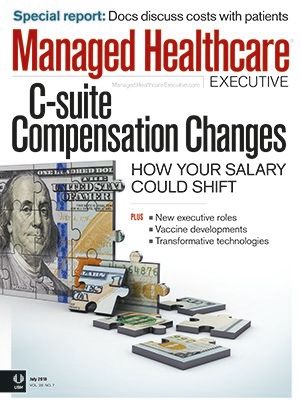How Healthcare Organizations are Rethinking Executive Compensation
How one public trust healthcare system overhauled its overall compensation program and successfully transformed its financial operations.
Steven Sullivan

Industry dynamics have forced healthcare organizations to move beyond “business as usual” in some significant ways. While all must embrace the “Triple Aim” of clinical quality, patient experience, and operational efficiency, how they structure their business strategy must be tailored to their individual situations. Some must focus more on quality; others on growth.
This issue’s cover story explores how developing an executive compensation plan that maps to the strategy can play a large role in a successful transformation. I couldn’t agree more.
We recently helped a $500 million public trust healthcare system located in a suburb that’s home to a large state university revise its executive compensation plan. The school’s faculty and staff comprise a major part of the local population. They have commercial health insurance and represent a healthier population in general than other areas.
Three larger healthcare systems located in the adjacent city have all made acquisition overtures at one time or another in the last five years.
The organization had an annual incentive program for executives in place for several years that measured various generic areas of performance. As the board began to identify market share growth and financial performance as critical to future success, it became clear that the existing compensation program needed an update.
The management team worked to better understand the new business strategy. The specific long-range goals were to:
- Grow the number of patients seeking ambulatory care in ambulatory settings versus the ER; and
- Increase the overall number served across emergency, urgent, and outpatient care.
The nature of the relatively close-knit community is such that word-of-mouth referrals have great utility in increasing patient volume. The management team and the board estimated that establishing and staffing the required number of ambulatory care locations would take five to seven years. Similarly, the changes that would be required to routinely provide levels of quality and care sufficient to engender highly positive referrals in the community and then absorb the resulting increase in number served would also take at least five to seven years.
Based on the sustained levels of collaboration and effort required to succeed against these goals, the board determined that the organization’s executive compensation philosophy would be modified to incorporate a multi-year pay-for-performance strategy-an approach often used in public and other for-profit companies. However, based on its responsibilities as a public trust, the board agreed that earned incentives coupled with base salaries should never position executive total direct compensation at unreasonably high levels as compared to an annual review of similarly-situated organizations.
The result is a performance share plan for executives with annual share grants and three-year overlapping performance periods. The shares will grow in value as the organization increases its patients’ “willing-to-recommend” ratings, and achieves growth in ambulatory care.
In addition, executives have an annual incentive plan driven by performance in clinical, service, team, and operational excellence. Metrics are selected so that strong annual performance predicts success in the long-term plan.
While the organization is only a year into the plan, there is noticeable performance uptick on several of the short-term “excellence” metrics, and the leadership team now includes a discussion regarding their long-term incentive plan performance in their regular weekly meetings.
The strategy behind the overall compensation program is that as the team improves performance against the annual metrics, those positive outcomes achieved will contribute to the longer-range growth goals.
Steven Sullivan, a managing director with Pearl Meyer’s Houston office, has more than 20 years of consulting and industry experience assisting clients in executing their strategic human resources and compensation initiatives. His focus has been in the areas of executive compensation program benchmarking, design, and oversight in the healthcare industry and for tax-exempt businesses.

Extending the Capabilities of the EHR Through Automation
August 2nd 2023Welcome back to another episode of "Tuning In to the C-Suite," where Briana Contreras, an editor of Managed Healthcare Executive, had the pleasure of chatting with Cindy Gaines, chief clinical transformation officer at Lumeon.
Listen